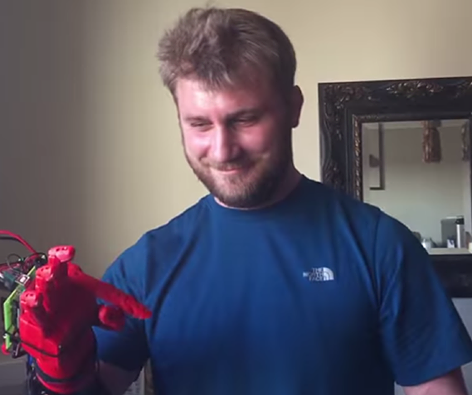Scroll down for video and design files.
A quadruple amputee in the US has become the first wounded soldier to wear a 3D printed bionic hand that was designed in the UK.
Taylor, who lost his limbs in an IED blast whilst serving in the military in Afghanistan, and his friend Neal have spent the last two months working on the Dextrus V1.2, - an affordable bionic hand prototype.
Neal, an engineer from Iowa, decided to 3D print a robotic hand for his friend with the goal of developing a prosthetic that was more functional and easier to use than Taylor’s current one.
Neal started by 3D printing Joel's Open Hand Projects' open-source Dextrus design with the Da Vinci 1.0 3D printer. He then fit Taylor with the bionic hand and completed his first proof of concept. It was important for Neal to test the prosthetic fit and see if Taylor could control the bionic hand.
Taylor can be seen in the video moving the Dextrus fingers by flexing his residual muscles which are covered with EMG sensors.
The engineer now plans to redesign the arm for its first full-featured build by adding a 2-axis wrist, an elbow strap with push-button tension adjustment, and additional programming to allow for switching between several grip modes.
Neal said: “In its completed form, this arm may not end up being the go-to for daily usage compared to the professional-made prosthetics that Taylor has, but that’s fine because this project will have served as the test bed for trying out new features and creating a control program to work as easily and intuitively as possible.”
“The next time Taylor is having a professional-made prosthetic arm put together, he will be able to provide this 3D-printed arm as an example of every feature and program behavior that he will want the new arm to include.”
“For our 3D-printed arm having cost between 1% and 2% of what his last prosthetic arm was, there won’t be any excuse for it not to have all of its features. The use of 3D printing and open-source programming to enable rapid prototyping at low-cost, combined with having an open-source hand design like the Dextrus available to work with, have been crucial to making this project a reality.”
Neal believes in working open-source and plans to share his adaptions and upgrades to the Dextrus design with the maker community.
Joel, who designed the Dextrus during his Open Hand Project crowd-funding campaign, said he was happy to see so many researchers using his open-source developments to make strides in prosthetic technology.
Joel added: “This was always the goal, to release my designs and have incredible engineers like Neal take them and adapt them for their own purposes and to help someone else. It’s awesome to think a design I worked on in my bedroom at my parent’s house has been downloaded and built by people I’ve never met across the world.”
"It's great that Neal is sharing his designs and ideas too. This is the fastest way to creating better prosthetics for the people who need them everywhere."
Here Neal tests the 3D printed hand's functionality and control with his own arm.
If you want to 3D print your own Dextrus, the files are waiting for you on Intructables: Dextrus V1.1 Robotic Hand.

